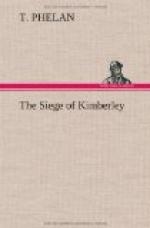All these things, however, were now of secondary interest; it was the horseflesh peril that held the field. The masses were still determined never to submit to such an ordinance on the eve of the twentieth century; the innovation was too horrible. But the military, undaunted by popular opposition, were bent on making the horse acceptable; and their next move was to equalise the proportions of the two species that constituted a ration. The effect of this little twist of the screw was to reduce our meat ration (nobody allowed that horseflesh was meat!) to two ounces. The ounces from the ribs of the tougher animal were left severely alone—by the majority of the people. On the other hand, controversialists of strong anti-vegetarian views were forced to experiment. Their verdicts differed. Some of them knew a little about cooking, and they were “not surprised.” Others, who knew nothing of cooking, re-harnessed the horse at once; while a third school, expert in the culinary art, triumphantly overcame their prejudices, but were afraid openly to smack their lips. Unanimous approval or toleration was never forthcoming, and, for myself, I am most inclined to respect the judgment of the heretics who pronounced the equine dish “as good as the meat that was going.” It was certainly not better, and to make it universally acceptable it would require to have been very much better.
On one “point” agreement obtained; it was admitted on all sides that the horse tasted sweet. One might suppose the adjective to be a recommendation; but it was not so; quite the contrary (the nearer the bone, etc. does not apply to a saddle of horseflesh). And yet there were people who liked their porridge sweet! who, after wasting their allowance of sugar in it, would go running about the streets to borrow a little sugar for their tea. Had it been practicable to utilise a little horse-essence for the tea, all would be well. But it would hardly do. Nobody ventured even to hint at the adoption of such a course to a neighbour; with borrowing rampant it was undesirable to be on other than amicable terms with the lady next door.
Time passed, and our antipathy to horseflesh abated not a jot. It did not improve on acquaintance, we were told by those who tried it, while the self-respecting persons who would not so demean themselves were no less bitter in their diatribes. It was useless to argue that the horse was a “clean” animal. He was deemed too useful, too tough, too sinewy, too hard-working to be digestible. We could not connect a horse-chop with what was fit for human consumption. Most of us indulgently spared the butcher the trouble of weighing it; we preferred—with an air of dignity—to take the two ounces that civilisation sanctioned, and to forego the rest. And there were numbers who did not consider it worth while enduring a certain jostling for the right half of their ration; it was not worth it—and




